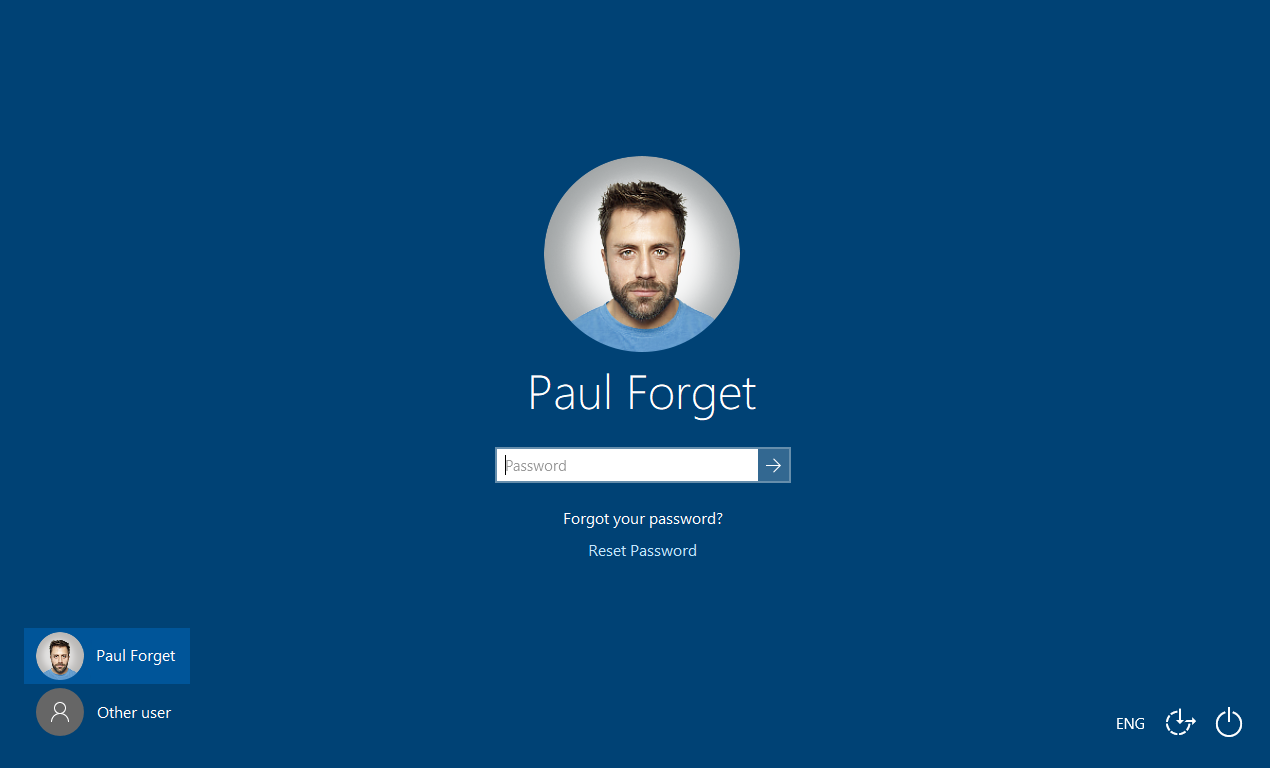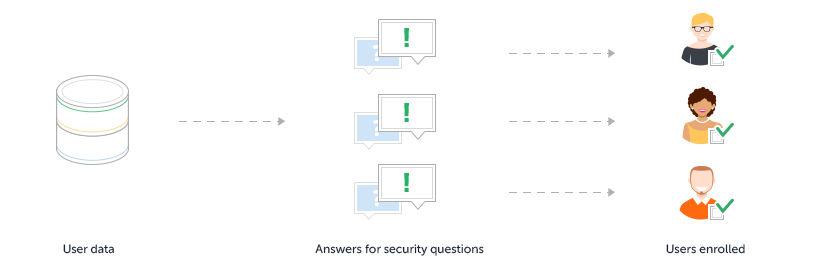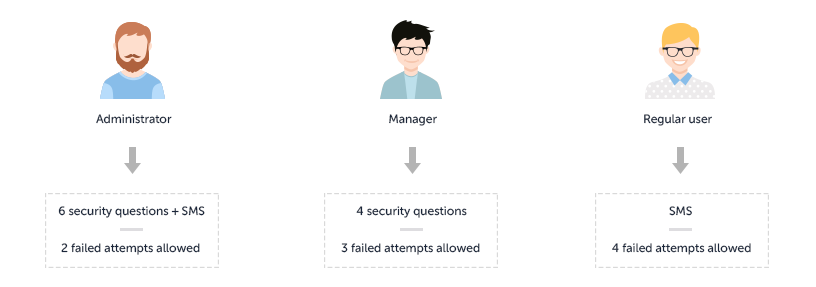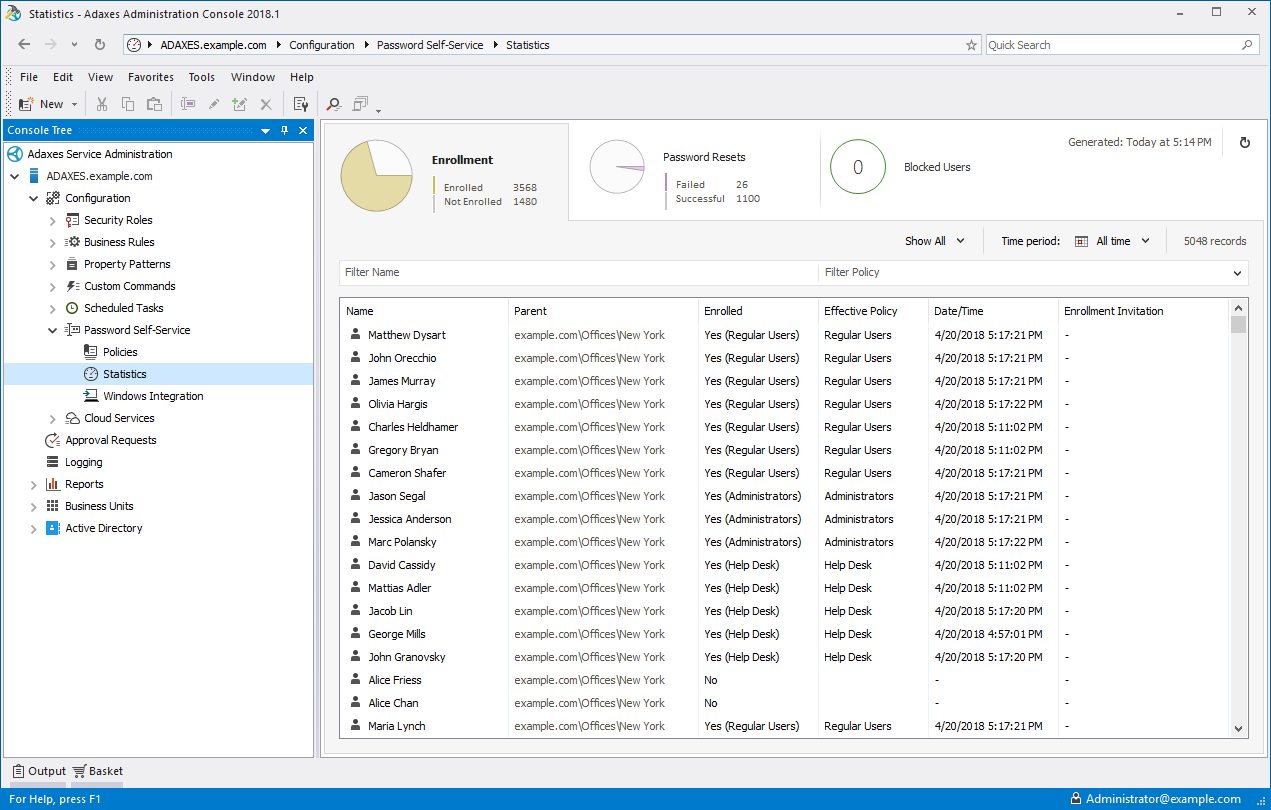Help Desk bogged down in time consuming password resets?
Adaxes Password Self-Service solves one of the most common problems for any organisation: forgotten passwords and locked accounts. Instead of calling the help desk and going through a frustrating password reset procedure on the phone, which can take a lot of time, be unreliable and prone to mistakes and exploits, Adaxes allows users to reset their own passwords by themselves without any intervention from the IT staff whatsoever.
Having Password Self-Service in place allows you to significantly reduce the downtime caused by users being locked out while waiting for their passwords to be reset for them. And, in addition to that, you also cut down the time your IT staff spends on resetting the passwords for users instead of doing something more productive.
How It Works
Once users find themselves with a forgotten password, all they need to do is follow a simple user-friendly procedure. After clicking the Reset Password link provided by Adaxes, they need to verify their identity either by entering a security code sent to them by SMS or by answering security questions. Both methods can also be used at the same time, effectively providing two-factor authentication. After the identity is verified, users can unlock their account, reset their password, log in and finally start working. As simple as that!
Users can launch the self-password reset procedure either straight from the Windows logon screen on their machines or they can do it via the Web Interface using a browser on any device, like, for example, their phones. Password self-service link can also be integrated into your own portals or applications, so that users can start the procedure from there.

Enrollment
If you enable the Q&A option for identity verification, it means that to use password self-service first users need to provide answers to security questions during a one-time enrollment procedure. To make sure that all users are on board with it, Adaxes can regularly send them email reminders, show enrollment invitation balloons in the Windows notification area, display a pop-up every time users log in to the Web Interface, etc.
Adaxes also supports auto-enrolling users for password self-service in bulk. It can be useful, if you store some user-specific information that can be used as answers for security questions, such as SSNs, IDs, places of birth, etc. It can also be done automatically on a regular basis, so that all users including new ones are always covered.

Offline and Offsite
Adaxes Self-Password Reset allows users to reset their passwords even when they are not on the corporate network. So, for example, when users take domain-connected laptops home or on a business trip and forget their password, normally they will be locked away from their machines until they come back, even if somebody from the help desk resets their password in AD. But with Adaxes users can simply go through the same password self-service procedure and log in to the laptop with their new password. No VPN or other additional means required.

Security
For password self-service it’s important to find the right balance between maximising security and maintaining the ease of use for your users. Adaxes allows you to find the sweet spot for absolutely everyone, as it allows applying different policies to different users, so that stricter password reset procedures apply to more security-sensitive accounts. For example, members of the IT staff or executives can be forced to answer more security questions than regular users, have two-factor verification enforced and be allowed less failed attempts.

By default, after a certain number of failed attempts, Adaxes automatically blocks access to password self-service for a specific period of time. This way any brute-force attacks or other suspicious activities are eliminated straight away.
After a password is successfully reset using the self-service procedure, users get an email notification about it. So that, if they didn’t do it, they can contact the IT department and corresponding measures will be immediately taken.
To provide an additional security level to password self-service process, you can add an approval step to it. So, after a user successfully goes through the identity verification, the password will only be reset after an approval is granted for it. The list of approvers can contain members of IT staff, the manager of the user, their colleagues, etc.

Monitoring
Adaxes provides monitoring capabilities, which means that administrators can always keep an eye on things like how the enrollment progress is going, successful and failed self-password reset attempts, etc. With such approach any problems that may come up can be easily identified and dealt with. For example, if a certain policy results in many failed password reset attempts, administrators might need to make that policy less strict.

With password self-service in place you can take away a lot of frustration from your environment, make password resets more reliable and available to everyone everywhere and at any time. As a result, you can save lots of resources for your organisation, in terms of both time and money, that would be otherwise wasted.
Other Features
Active Directory Management
Adaxes features a rule-based platform for Active Directory, Exchange and Office 365 automation, provides an enhanced web-based management environment, gives you a role-based access control model for delegating privileges, adds security with approval-based workflow, allows enforcing corporate data standards and much more.
More InfoActive Directory Automation
Adaxes provides rule-based automation for Active Directory, Exchange and Office 365. It allows executing sets of operations that are governed by if/else conditions before or after certain events in AD. So, for example, after the department of a user is changed, Adaxes can then automatically update the user’s group membership and send an email notification to the user’s manager, following the rules you define.
More InfoActive Directory Provisioning
Using condition-based rules you can automate the entire user provisioning process. Once a new user account is created in Active Directory, Adaxes will automatically execute the rest of onboarding procedures for you: moving the user account to a correct OU, adding it to necessary groups, creating and configuring an Exchange mailbox, assigning Office 365 licences, enabling the user for Skype for Business, creating and sharing a home folder, sending a welcome email, etc. Similarly to that, you can also automate all operations associated with user updates. Finally, when a user is terminated, Adaxes can automatically execute all the provisioning operations in reverse, ensuring instant and errorless offboarding.
More InfoWeb Interface for Active Directory
Adaxes Web Interface enables Active Directory management via a standard web browser. It features a modern responsive design, so users can access it on their laptops, tablets, phones or any other devices. You can set up different Web Interfaces specifically tuned for the needs of different job roles, like administrators, help desk, HR, managers, and others, giving them a clean and intuitive way to access the tasks they need. Adaxes Web Interface also incorporates Exchange and Office 365 management, so users get a single console without the need to learn and use multiple tools for their day-to-day routines.
More InfoWeb Interface Customisation
The Adaxes Web Interface is fully customisable, so you can configure it to have the exact views, forms, and operations that each user needs. For example, administrators can have a full set of management activities in Active Directory, Exchange and Office 365 across the entire environment, whereas managers can be set to view just their subordinates and only be able to update their group membership, assign Office 365 licences and change certain AD properties.
More InfoActive Directory Self Service
Adaxes Web Interface can act as a self-service portal for regular users. You can granularly specify, which operations they have access to, like updating their personal info, changing their own password, searching Active Directory, managing own group membership, updating Office 365 licences, etc.
More InfoActive Directory Password Self-Service
Adaxes Password Self-Service allows users to reset forgotten passwords and unlock accounts by themselves. To do that they need to go through a simple identity verification procedure that may involve answering security questions, SMS verification, using authenticator apps like Google Authenticator, Authy and others. A self-password reset can be accessed from the Windows logon screen, Adaxes Web Interface or it can be integrated into your own portal.
More InfoExchange Management and Automation
Adaxes automates Exchange mailbox management both on-premises and in Office 365. For example, after creating a new user account in Active Directory, Adaxes can automatically create an Exchange mailbox for the user. The database distribution of mailboxes can be done based on the first letter of the users’ surname, least number of mailboxes in the DB, the round-robin method, etc. Adaxes can then configure the mailbox, e.g. modify storage quotas or enable mailbox features like Unified Messaging or Archiving.
More InfoOffice 365 Automation and management
Adaxes can automatically assign and revoke Office 365 licences using condition-based rules. For example, when a new user is created in Active Directory, Adaxes can activate an account in Office 365 for the user and assign the necessary O365 licences according to the rules you define. Different licences can be assigned to different users based on their job title, department, location, etc.
More InfoActive Directory Role-Based Security
Adaxes introduces Role-Based Access Control for Active Directory, Exchange and Office 365. In a role-based delegation model, instead of assigning permissions to users, they are assigned to roles that correspond to actual job functions. So, when you need to change privileges for all users with the same job function, all you need to do is modify the permissions of the associated role. Assigning roles to users is done in a centralised manner, allowing you to easily control, who can do what and where. With role-based delegation, you can granularly specify, which parts of Active Directory are visible to users. For example, you can allow certain users to only view AD objects located in their own OU, while hiding the rest of the Active Directory structure from them.
More InfoApproval-Based Workflow
Adaxes allows you to add an approval step to practically any operation in Active Directory, Exchange and Office 365. For example, you can delegate user creation to HR, but after they fill in the form and click Create, Adaxes can suspend the operation and only proceed once a member of IT staff reviews and approves it. For more complex and security-sensitive scenarios, you can set up multi-level approvals. Such an approach allows delegating more tasks to lower level staff without taking the risk of losing control over them.
More InfoActive Directory Reports
Adaxes comes with reporting capabilities, allowing you to monitor and analyse what’s going on in your environment. Out of the box, you get more than 200 reports, which should cover the majority of your requirements. For more demanding scenarios Adaxes also provides various ways to create custom reports, including using your own scripts. It enables you to create reports of practically any complexity that can be specific to your organisation's needs. To deliver reports to users Adaxes supports centralised scheduling and also provides a self-scheduling option, allowing users to choose by themselves, which reports they want to receive and when.
More InfoCustom Commands for Active Directory
With Custom Commands users can launch complex multi-step operations in one go. For example, if you need to send a user on vacation, you can do it with just one click in the Web Interface. The operation can include steps like disabling the user account, adding it to a corresponding group, sending a notification to the user’s manager, etc. Such an approach allows you to delegate complicated tasks to users and not worry that they will miss a step or do something wrong. Besides, you don’t over-privilege them, as you only give out permissions to execute the Custom Command as a whole, not the individual steps it consists of. Administrators can also use Custom Commands in their day-to-day routines to make the management process simpler and accomplish the same results with a lot fewer clicks.
More InfoScheduled Tasks for Active Directory Management
Adaxes allows you to automate various routine management tasks by scheduling them. For example, it can automatically de-provision inactive accounts in AD, allocate users to necessary groups, maintain OU structure, etc. You can also schedule tasks like importing new users from CSV. Automating such a sensitive operation doesn’t mean that you need to sacrifice any control, as you can add an approval step to it. This way users will be created in AD only after a member of IT staff reviews and approves the operation. You can also use scheduled tasks to send various notifications to users, like reminders about their password or account expiration.
More InfoActive Directory Delegation
Active Directory management involves many different operations that require administrative privileges granted by default to AD administrators only. Though operations like password reset or account unlock are pretty simple, they take a lot of time of highly-skilled IT staff, not allowing them to focus on more complex and important issues. Active Directory delegation helps you optimise the productivity of the IT department by letting non-administrative users (e.g. department managers or Help Desk operators) perform certain administrative activities in Active Directory.
More Info

